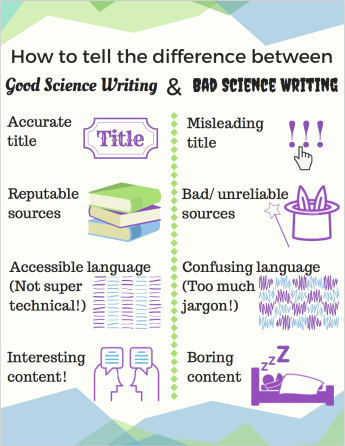


Infographic by Amy Foltz
The rhetorical elements of science writing should work together to communicate an overarching idea to the popular media, or simply, people outside the scientific community.
The most essential aspect of good science writing is to stay true to the research or science being reported on. The title needs to be engaging without misleading the audience. And whether it’s science or scientific, any kind of writing should be written with the audience in mind. Science writing is geared more towards an audience who is unfamiliar with the specifics of the reported science, and an unfamiliar audience wants to know the WHAT, WHY, and HOW. It should utilize plain, widely accessible language to communicate foreign ideas and concepts. Some of the effective rhetorical devices good science writers often utilize are metaphors and classic literature archetypes. These kinds of elements work to simplify scientific concepts and situations without contradicting the findings.
The easiest way to create bad science writing is to misrepresent or contradict the reported science. This might include using a “clickbait” title to lure in readers, poorly constructed metaphors that oversimplify a problem or concept, or excluding essential information about the scientific process or those involved.
Another type of poor science writing is writing that borders on scientific writing. This would include field-specific jargon and extraneous detail about scientific concepts that the average person would not understand.